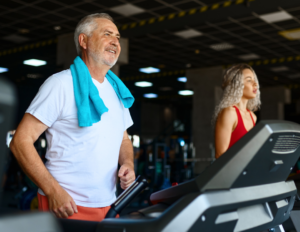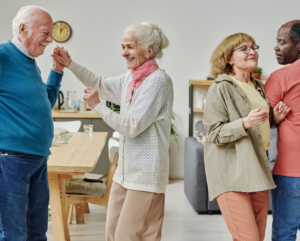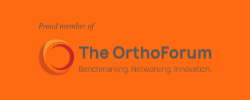Known as a “silent disease,” osteoporosis affects the lives of millions of Americans.
Millions of Americans have osteoporosis or are at risk for this disease because of low bone mass. One in two women and up to one in four men over the age of 50 will break a bone due to osteoporosis. The disease, which is not a normal part of aging, can weaken the bones causing bone fractures, pain, suffering, and can rob many people – mostly women – of their ability to live independently as they grow older.
Osteoporosis is preventable
The good news is, by starting young, osteoporosis is preventable if you maintain a healthy lifestyle. Bone is living tissue, according to the National Institutes of Health (NIH): “The inside of bone looks something like a honeycomb. When you have osteoporosis, the spaces in this honeycomb grow larger, and the bone that forms the honeycomb gets smaller. The outer shell of your bones also gets thinner. All of this makes your bones weaker.”
Your body constantly breaks down old bone and replaces it with new bone. When you’re young, this break-down/build-up-process stays in balance and bones stay strong. However, at about age 30, bone mass stops increasing. If your body isn’t getting enough calcium, it will take calcium from your bones. More bone may be broken down and lost than is replaced as you reach your 40s and 50s. This can cause bones to break. The most common osteoporosis-related fractures are the hip, backbone (spine), forearm and wrist.
How do you know if you have osteoporosis?
Osteoporosis is a “silent disease” because you don’t know you have it or feel bone loss until you break a bone, unless you get a bone density test. The test uses X-rays to measure how many grams of calcium and other bone minerals are packed into a segment of bone. The bones that are most commonly tested are in the spine, hip and sometimes the forearm.
Who can get osteoporosis?
Anyone can get osteoporosis at any age. However, it’s more common in women after menopause. Men make up about 20 percent of all cases. Men have a higher peak bone mass (PBM) and lose mass slower as they age, compared to women. Women have less bone tissue, and, after menopause, they lose bone mass quickly for several years. After that, bone loss continues, but at a slower rate. By age 65 or 70, men and women lose bone at the same rate.
PBM is the greatest amount of bone a person can build up. Most men and women reach PBM between the ages of 17 to 25. The higher the PBM, the lower your risk of getting osteoporosis later in life.
Who’s at the greatest risk?
Women and men are at a greater risk of osteoporosis-caused fractures if they:
- Have broken a bone after age 50
- Are a woman who had ovaries removed before her periods stopped, and/or had early menopause
- Have not gotten enough calcium and/or vitamin D throughout their lives
- Have a small body frame
- Are physically inactive or had a period of extended bed rest
- Smoke
- Take certain medicines, especially those for arthritis, asthma and some cancer drugs, including steroids, glucocorticoids and some anti-seizure drugs
- Have a family history of broken bones or osteoporosis
- Have osteopenia (your doctor may call it low bone mass) – this means you have already started losing bone and are at a much higher risk of having osteoporosis
How is it diagnosed?
Your doctor may recommend a bone density test at age 65, or younger if you have broken a bone recently. You may also want to be tested earlier if you smoke, have more than three drinks daily, take corticosteroids or have a low body mass index.
A Dual-energy X-ray absorptiometry scan (DXA or DEXA) is the most common bone mineral density test. This painless, quick scan can diagnose osteoporosis and osteopenia and can determine your chances of breaking a bone. It is also used to check your progress if you are taking medicine to rebuild your bones.
Prevention and treatment
Prevention means keeping as much bone as possible for as long as you can. Prevention begins in early childhood, during the best bone-building years. The goal when you are young is to achieve your PBM. Treatment for osteoporosis and osteopenia includes all the prevention tips listed below.
You cannot change the causes of osteoporosis or osteopenia related to age, gender or family history. However, even if you have osteopenia, there are still things you can do to halt bone loss and prevent osteoporosis later in life. You have control over the following factors that also cause osteoporosis and osteopenia, according to the NIH:
- Get enough calcium every day – especially before age 20. Find out how much calcium you need, by age and gender. Good sources of calcium include milk and other dairy products such as cheese or yogurt, dark-green leafy vegetables, soybeans, canned sardines or salmon with bones and calcium-fortified foods. The best sources of calcium are from food, not supplements. Food contains other important nutrients that help the body use calcium.
- You need vitamin D – this helps your body absorb calcium. Find out how much vitamin D your body needs. You can get vitamin D from fatty fish like salmon, mackerel and tuna; fish-liver oils; beef liver; egg yolks; fortified milk/milk products and fortified cereals. An important source of vitamin D is from your skin when sunlight hits it. Spending about 15 minutes in the sun, twice a week, will help your body create enough vitamin D. However, note that older people’s skin makes less vitamin D. Vitamin D levels often drop in the winter and in northern areas where these is less sunlight. If your vitamin D level is still too low, ask your doctor if you need a vitamin D3 supplement.
- Perform regular weight-bearing exercise throughout your life – weight-bearing activities force your body to work against gravity, prompting your body to produce new bone. Like muscles, bones need a workout to stay strong. Try to get at least 30 minutes per day of weight-bearing activity – walking, tennis/racquet sports, hiking, climbing stairs, jumping rope, heavy gardening, yoga or dancing. It’s also important to do muscle-strengthening activities like lifting weights or using a resistance band. As your muscles pull on your bones, the bones get stronger. Strength training will give you key benefits that aerobic activity cannot provide. Strength training makes you more flexible and lowers your risk of a fall. If you are inactive, talk with your doctor about starting an exercise program and strength training.
- Don’t smoke – Smoking keeps your body from absorbing calcium. There are many tools to help you quit.
- Limit alcohol – women should not have more than one drink per day; two for men. That includes beer, wine, or liquor.
- Drink fewer cola beverages – some studies show that cola soft drinks, more than other carbonated drinks, lead to bone loss. This may be caused by the phosphorus contained in sodas, which keeps your body from absorbing calcium. And/or it may be that by drinking sodas, you’re not drinking as much calcium-rich milk.
- Low hormone levels – low estrogen in women or testosterone in men – can increase the risk of osteoporosis. Ask your doctor if you need to have your hormone levels checked. Also, ask him or her if any of your medications could be contributing to bone loss.
- Fall–proof your home – falls are the leading cause of broken bones, especially hips. When your bones are weak, a simple fall can cause a broken bone. This can mean a trip to urgent care and maybe surgery, pain, reduced mobility even after it has healed, and emotional issues including depression as you recuperate from the fracture. Home is where most falls happen, probably because we move around without thinking about safety.
Start now to prevent osteoporosis
Some of these prevention and treatment tips may mean major lifestyle changes for you, so go slow. Do not try to make all these changes at once. Focus on what you’re eating and then start adding more exercise. If you need to quit smoking or drinking, talk to your doctor and get guidance on what to work on next.
Start young to prevent osteoporosis. These organizations can provide more information:
National Institutes of Health Osteoporosis and Related Bone Diseases National Resource Center














